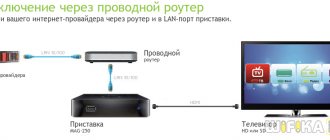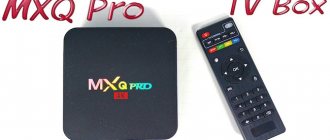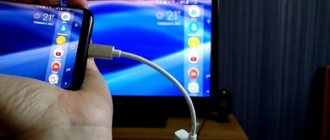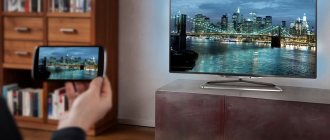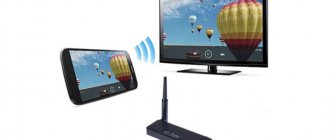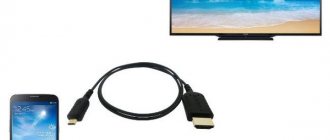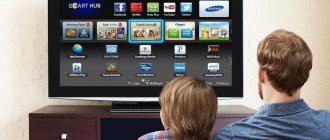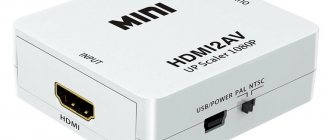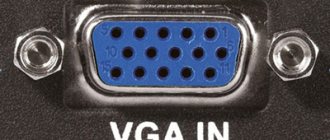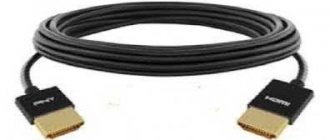You can connect your smartphone to your TV in various ways, using cables or over the air. One popular and simple wireless option is the Wi-Fi Direct option. In this article you will learn what it is, how it works, and how to use Wi-Fi Direct on TV. This feature is supported by most modern home electronics companies.
What is Wi-Fi Direct
Wi - Fi Direct is one of the means for wireless data transfer. With its help, a TV without a router can serve as a signal relay point. By connecting a mobile phone or laptop to it, you can display the image directly on the screen. Two or more devices are connected into one network without additional connecting devices.
A Wi-Fi module is available in all modern devices. Wi-Fi Direct technology is almost identical to it. Using this means of communication allows you to transmit information at a frequency of 2.4 GHz over a distance of about 200 meters. More expensive modules operate in the 5 GHz band.
A little history
The standard we are considering was developed by WECA several years ago. This company is actively involved in all kinds of technologies related to Wi-Fi.
After developing a full-fledged standard that allows the Internet to be transmitted over the air, creating technology for transferring data between devices was a logical step.
To do this, it was necessary to come up with something that would allow the use of Wi-Fi without routers and routers.
Therefore, they came up with a chip that is placed inside a smartphone, tablet or other device. It is, in fact, a mini-router.
In general, WECA is an alliance of the largest Wi-Fi equipment manufacturers.
Initially it included the following organizations:
- 3Com;
- Cisco, which was then called Aironet;
- Intersil (aka Harris Semiconductor);
- Agere (aka Lucent);
- Nokia;
- Symbol Technologies.
Most of them still belong to the alliance. They support all developments, including the development of Direct.
Pros and cons of technology
Like all communication methods, Wi-Fi Direct on a TV has its advantages and disadvantages. Compared to other solutions, it has undeniable advantages.
- Easy connection. There is no need to purchase a router. A network will be created between two devices, you connect to it and use it.
- High data transfer speed. Most modern devices are equipped by manufacturers with the appropriate protocol.
- Wi-Fi Direct is supported by most modern devices. Therefore, there will be no connection problems with your TV, tablet or smartphone.
- Universality of technology. It is supported by all operating systems from Windows 10 to Android and iOS.
On a note!
If, for example, an LG or Samsung TV does not have this function, you can purchase a universal adapter for any TV model. It will work as a built-in module. Let us also list the disadvantages of the technology.
- Low level of security. A user with any mobile device can connect to your connection.
- Small connection area. Wi-Fi Direct works within one room. TVs and mobile devices do not have such powerful antennas for transmitting and receiving signals as routers.
- Battery drains quickly. Due to the high data transfer speed on a smartphone, energy is wasted quickly.
Solution
If connection problems persist, then you need to take a number of simple but effective actions. Most often, these methods help correct the situation and restore the operation of the TV with Wi-Fi.
Reboot
You need to reboot the TV and router. In some cases, the software begins to work incorrectly, which is easily corrected by turning on the devices again. The main thing when rebooting the TV is to disconnect it from the local network. For some models, you will need to not just turn it off, but cut it off from the power supply for 10-15 seconds.
When rebooting the router, you need to wait about 15 seconds before turning on the device again. This is necessary to completely close the previous session. Only in this case the settings will be reset. Otherwise, the turned on router will work within the previous session.
Manual data entry
If automatic configuration does not produce results, then the data will need to be entered manually. To do this, you need to open the Wi-Fi settings, find the “IP address” line and enter an IP from the local range. You can find the appropriate values in the router administration panel.
The value 255.255.255.0 is usually entered in the “Subnet Mask” field. The parameter is responsible for redirecting clients on the local network. The IP router address that is used to open the router settings must fit into the “Gateway” line.
Important! You can also find out the “Subnet Mask” and “Gateway” parameters through any other computer connected to the router. You need to launch the command line, where you need to enter “ipconfig /all” and confirm the action.
DNS errors
DNS errors must be corrected to connect directly to the Internet, avoiding the manufacturer's servers. You can find out the DNS server from your provider by contacting their support service. There are also open servers from large companies (Google and Yandex). To use Google address servers, you must specify 8.8.8.8 as the primary IP server, and 8.8.8.4 as the secondary one.
Important! In some cases, you cannot specify an additional address; then only the main IP server is entered.
Changing the connection method
If you connected to Wi-Fi by manually entering a password, you should try using WPS. WiFi Protected Setup is a technology that allows you to quickly connect your TV to the Internet. You need to activate it not only on the TV, but also on the router. To do this, you need to inspect the device body for the presence of a corresponding button or open the control panel.
How to connect a smartphone to TV via wi-fi direct
To enable Wi-Fi Direct, you need to know if your TV model has this function . The connection procedure for all models will look the same, be it a Samsung or Sony TV.
Turn on the function on TV
- Go to the “Settings” menu. On the remote, this is the “home” or “function” button.
- Find “Network” and go to this item.
- Click on the “Wi-fi direct” button. Wi-Fi must be active.
- If the name of your device is not named, enter it in the appropriate line.
After this, the monitor of your mobile device will be displayed on the TV screen.
Enable the function on your smartphone
- Go to the “Settings” menu.
- Select "Network and Internet".
- Activate the Wi-fi function.
- Find your TV receiver in the list of found devices and connect to it.
- Wait for connection.
Most mobile devices already have the appropriate settings, and you don’t need to install anything additional to connect your TV to your smartphone.
Device registration
In general, the process of registering a “WiFi Direct” device (how to use it with a TV) can be divided into the following stages:
- press the “HOME” button and go to settings mode (“Settings” or “Settings”);
- go to the “Network” section -> “WiFi Direct” and check the “ON” checkbox;
- in the “WiFi Direct Settings” section, fill in the “Device Name” field.
- Launch is carried out through the “Options” button on the remote control, after which you need to select “Manual” -> “Other methods” in the menu, the SSID and encryption key.
Connecting your phone to TV via Wi-Fi
The process of pairing with other devices is generally universal and is performed as follows:
Personal computer with WiFi adapter or laptop. In the tray, you need to left-click on the network connections icon and select the desired SSID from the list. The device will require you to enter the password received in the previous paragraph, which must be entered. Once connected, you can use the following software to transfer multimedia content:
- "Windows Media Player". After starting the player, you need to open the “Stream” tab and check the “Automatically allow devices to play my media” function. Click the “Play” button, in the window that opens, find the desired content (movie, track, photo, etc.), right-click on the file to call up the contextual content and select “Play to” -> “Device_name” .
- Through Windows Explorer. You need to open the folder with the necessary content and, by calling the context menu on the file, also click “Play to”. Moreover, this approach is also applicable to directories, if it is necessary to reproduce the set of multimedia contained in them.
Advice. You can quickly open the Explorer window using the hot keys “Windows” + “E”.
Device running Android. In the settings section, you need to find the WiFi item and select the required SSID from the list provided, followed by entering the encryption key.
After a successful connection, a characteristic icon will appear in the top menu when a file is open (only photos, films or music tracks), when clicked, you will be able to select equipment for displaying information. At the end, you need to click the “Play” button.
- Instructions for setting up SMART TV on Sony TVs
By the way! To work with WiFi Direct technology on a smartphone, you can use software such as iMediaShare, DiXiM and the like. In the case of data transfer from iPhone devices, such programs are a direct necessity.
Special Wi-Fi Direct applications for Android
Although Wi-Fi wireless technology is built into operating systems, there are applications designed to make setting up this feature easier. You can also use them.
- Cast to TV. This application was developed for Android and has a clear interface that will not be difficult to understand even for beginners. The main advantages of Cast to TV are video transfer from a smartphone to a TV receiver, independent search for suitable devices, built-in file identification. One of the advantages of the application is the ability to remotely control the TV receiver. From your mobile device you can adjust the volume, rewind the video or pause playback.
- Cast Web Browser. Using this application, you can transfer videos, pictures, photos, movies and music to your television. The advantages of Cast Web Browser include a well-thought-out interface and easy-to-use controls. There is a function to turn off the mobile device during the broadcast. This is provided so that the battery charge does not drop too much. Using the application, you can go online, search for the files you need, such as movies, and then transfer them to your TV screen.
Smart TV does not work on TV: solution to all problems
It is difficult for television to compete with the Internet in terms of variety of video content, this is a known fact. But the situation is balanced by the Smart TV service - it actually allows you to use the TV for Internet surfing. The process of connecting it is simple, you only need an Internet connection and a minimum of effort to set up. But sometimes a problem arises - Smart TV does not work, which can be caused by several factors.
Features of using the function on iPhone
Let's consider connecting the Wi-Fi Direct function on the iPhone.
- First, you need to make sure that the latest version of the operating system is installed on your smartphone. If there was an update, you need to install it and then restart your mobile device.
- Also on the TV you need to check the OS update, as well as the Wi-Fi Direct connection.
- First, the feature is enabled on the device you want to connect to. Once in the “Menu”, go to the “Settings” section. Find "Wi-Fi Connection" and activate it.
- Then Wi-Fi on the phone turns on. Among the available networks, you should find the one that the TV creates (the TV name will be displayed).
- You can connect to the device by entering the Wi-Fi password indicated on the TV screen.
- If the connection does not occur, it means that a mistake was made somewhere. Check all the points carefully, especially that the password is entered correctly and whether there is an update. You can turn off and restart your iPhone.
Way to connect to TV via USB
A reliable, but rather archaic way to synchronize a smartphone with a TV is to connect via USB.
The connection procedure is as follows:
- Using a USB cable, connect your smartphone to the TV;
- Go to the settings of your phone, and select “Connect as USB drive” there;
- In the TV menu, go to “USB devices”, and in the menu that opens, select your smartphone model.
This will also come in handy: how to connect TV to your phone via HDMI.
Ordered signal streams
There are two main sets
rules for local circulation of large volumes of data. These are DLNA and Miracast. However, the latter is the most appropriate in this case. For each of them, leading manufacturers have developed a lot of programs.
DLNA supports
multimedia traffic: video, photo, music. To operate in wireless mode, a central switch with an access point is required. The server is a transmitting device on which a special program creates a server. The client simply displays the image on the screen. So software installed on a computer with DLNA uses a central switch to use the large TV screen.
Miracast
can operate in point-to-point mode and, in addition to providing transport for typical audio and video files, can stream desktop images. The developers have provided functionality that ensures smooth playback of the video stream and the absence of desynchronization. Establishing contact and beginning the exchange of signals occurs in a couple of touches. The video signal is transmitted using the H.264 codec in Full HD. The sound is processed in AC3 format in 5.1 format. A separate advantage is that the standard is supported by all smartphones equipped with an operating system starting with Android 4.2.
